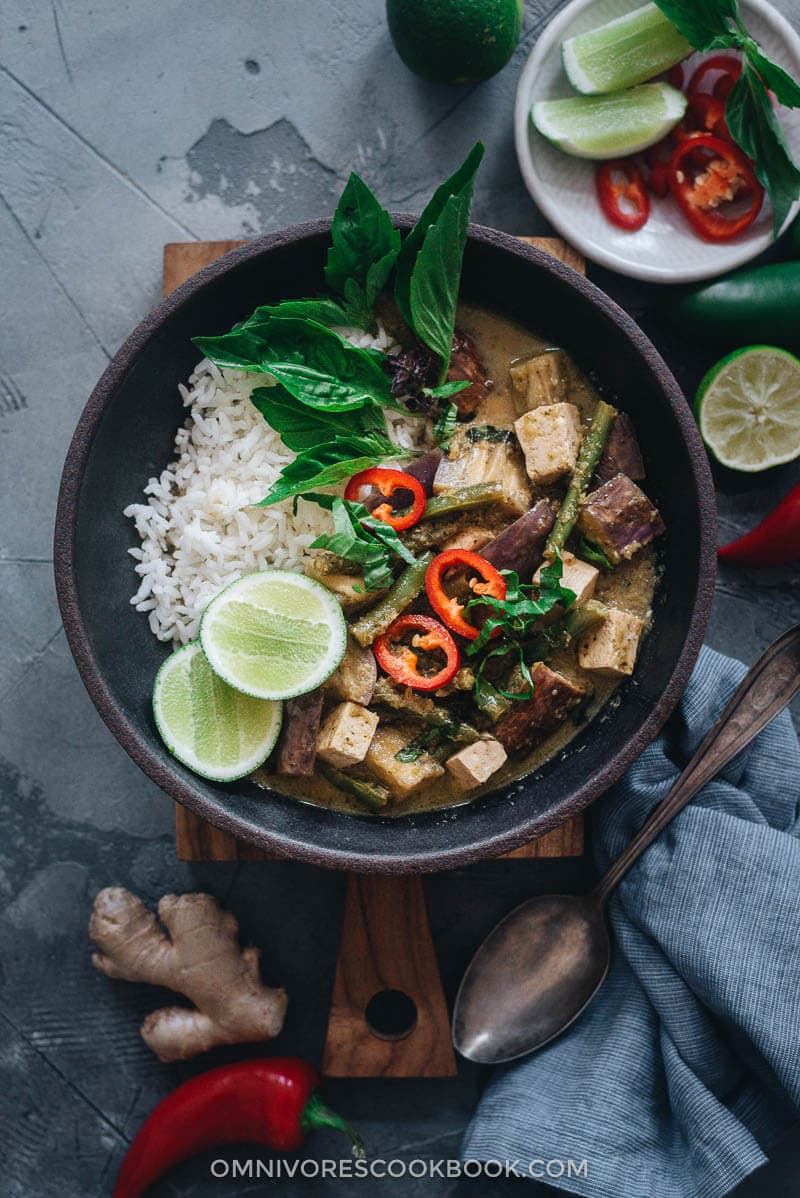
I didn’t encounter Thai food until college, but I was drawn to it immediately the first time I had beef satay and mango sticky rice. I loved the complex flavors of Thai cuisine. Even though it uses many spices and ingredients that are different from those in Chinese food, they share some similar characteristics. For example, the generous use of aromatics, bold spices, and fresh veggies to create a scrumptious meal that is full of color.
Since my husband adopted a plant-based lifestyle last year, Thai food has become an even bigger part of my life. Thai is perhaps one of the most vegan-friendly cuisines, thanks to the country’s tropical plants and fruits, and a cornucopia of explosive seasonings. Not to mention naturally creamy coconut and the magical jackfruit with a meaty texture. Often you will find that many dishes on a Thai menu are plant-based or vegan-friendly. Occasionally some will contain oyster or fish sauce, but when you make it at home you can just withhold those ingredients for a wonderfully sumptuous southeast Asian meal.
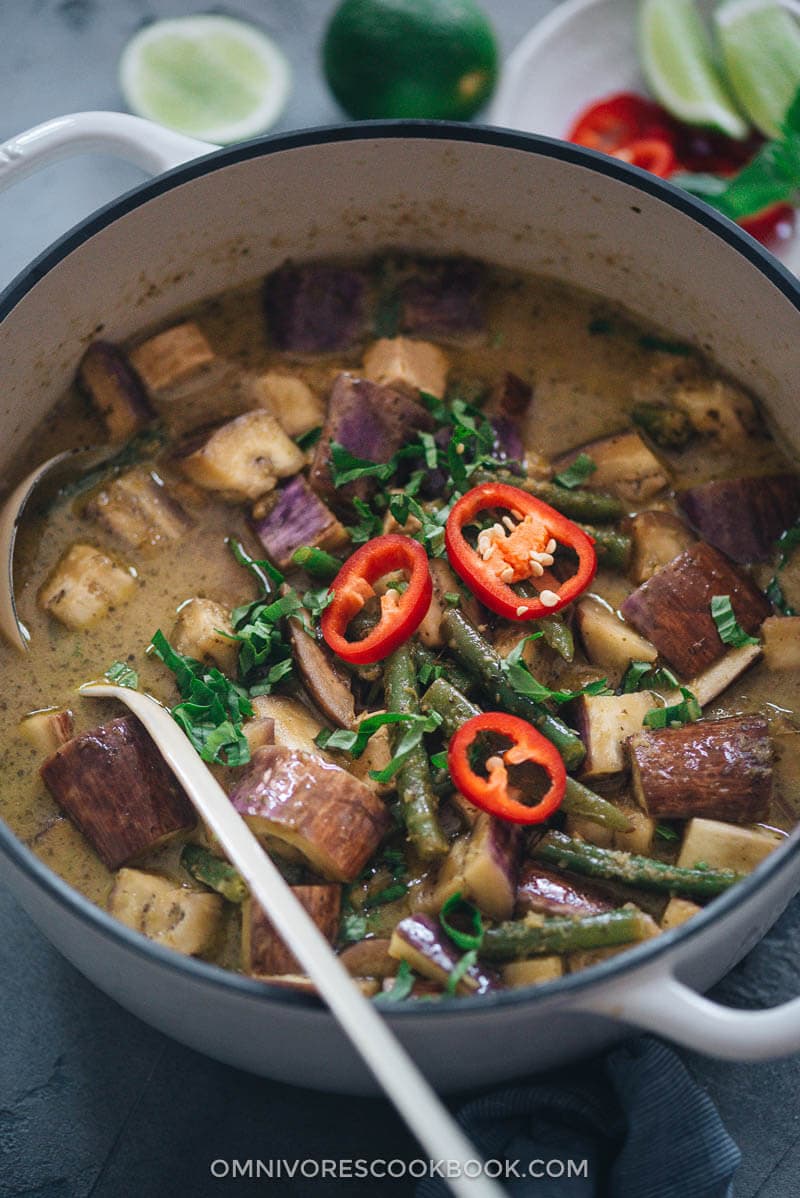
Taking it to the next level
When it comes to home cooking, I’m all about making a little extra effort to yield the ultimate taste. This is a strong tradition in both Chinese and Thai cuisines. Cultures where food is so binding and essential to a good and healthy life that families will pour their love into all the details. So I was really pleased when checking out the recipes in East Meets Vegan, a plant-based Asian cookbook, that author Sasha Gill goes all out in making the most flavorsome homemade spice blends. My husband tried his hand at her Jackfruit Massaman Curry, and I swear it was so good I had to have a go myself.
If you’re interested in Asian cuisine but prefer a healthier version, East Meets Vegan is definitely a great source of inspiration. The book is sectioned into different regions of Asia, covering Chinese, Thai, Indian, Singaporean & Malaysian, and Japanese. You will see classic dishes such as spring rolls, red bean pancakes, ramen, and mango lassi. The book also has fun dishes such as tandoori cauliflower wings, jackfruit biryani, and “butter chicken”.
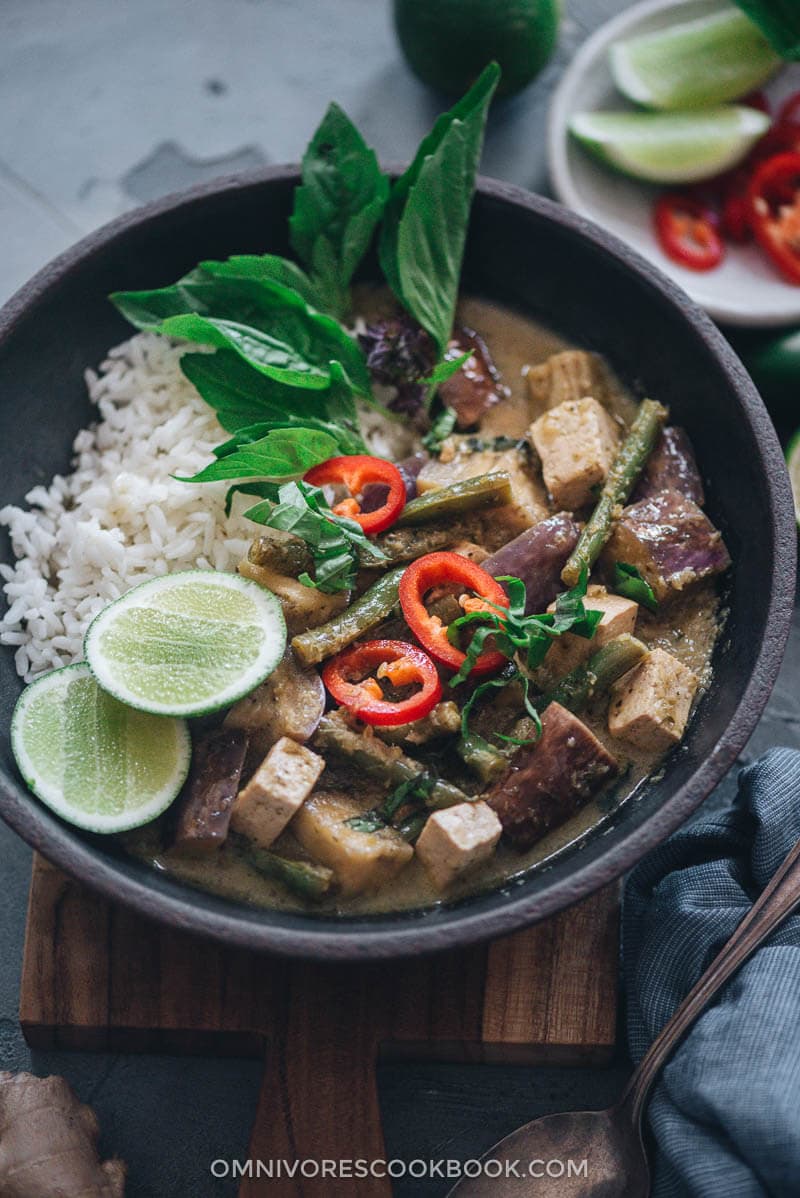
How to cook a flavorful vegan curry
1. Homemade curry paste
Although it might take a bit of extra time and elbow grease, making your own curry paste really makes a whole world of difference to your finished dish. Many bottled curry pastes contain fish sauce and/or shrimp paste, which are not plant-based. They usually taste extremely salty or contain preservatives, to extend their shelf-life. Even with bottles labeled as all-natural, you can still tell a difference because the homemade version uses much fresher ingredients.
Making the curry paste is actually super easy once you source the ingredients. Even though traditional Thai recipes always prefer a mortar and pestle, I found that blending everything in a food processor is fast and easy and doesn’t compromise on taste.

2. Cooking process
Making vegan Thai green curry is so easy. First, start by whipping up the ingredients for the curry paste in the food processor. Then you fry the paste in a small amount of coconut milk (no refined oils here) until your kitchen smell heavenly. Finally, you add the remaining ingredients in stages before allowing the curry to simmer gently, deepening the rich flavors and creating new textural dimensions. The curry will be ready the moment the veggies turn tender. But sometimes I like to make the curry in advance to allow the spices to blend more.
3. Choices of veggies
The great thing about making a vegan curry is, you can use many types of veggies you have on hand to make your own version. I used tofu as the main protein and eggplant and green beans as I love the textural contrast. But you can substitute them with many other ingredients. For example:
- Protein options: fried tofu, chopped tempeh, canned jackfruit, and chickpeas.
- Veggie options: cauliflower, broccoli, carrots, peas, bell peppers, mushrooms, kale, and spinach.
Note, the time needed to cook different veggies varies. For tougher veggies such as green beans, eggplant, mushrooms, carrots, peas, and cauliflower, you need 10 to 15 minutes depending on how you cut them. For broccoli, bell peppers, and kale, 2 to 3 minutes will give an al-dente texture and you shouldn’t cook them longer than 5 minutes. Lastly, very delicate veggies such as spinach (especial baby spinach), usually take 1 minute to cook through.
Add the veggies into the stew accordingly, to avoid overcooking them and turning them mushy.
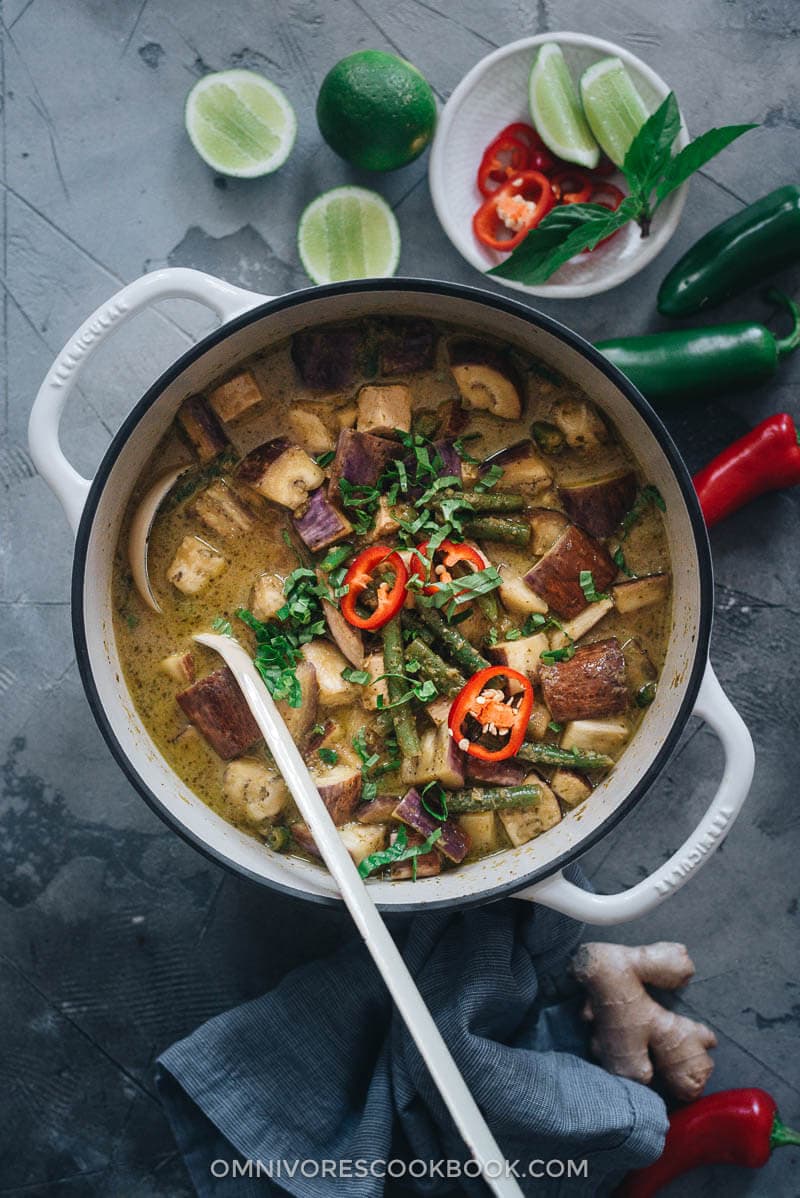
Afterthoughts
Like many other Asian recipes, this recipe might look very long but you’d be surprised how easy it is to cook it. I think the only challenge sourcing all the fresh aromatics if you don’t live in a big city or near an Asian market. The good news is, many grocery stores such as Whole Foods carry various herbs and spices, such as lemongrass and tamarind paste. If your local grocery store doesn’t have them, you can check out Amazon. I was surprised to find that you can now buy fresh lemongrass stalks from Amazon. I’ve included some Amazon links to the unusual products under this post.
I hope you enjoy the recipe and happy cooking!
More delicious vegan recipes
If you give this recipe a try, let us know! Leave a comment, rate it (once you’ve tried it), and take a picture and tag it @omnivorescookbook on Instagram! I’d love to see what you come up with.
Chinese Cooking Made Easy
Are you new to this website? This free email series is a great place to start. I’ll walk you through a few of my most popular recipes and show you how and why they work. You’ll quickly start to cook better Chinese food in your own kitchen.
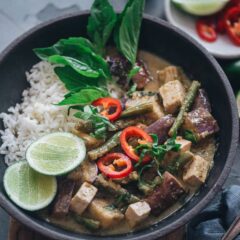
Vegan Thai Green Curry
Ingredients
Green curry paste
- 2 lemongrass stalks , white parts only, coarsely chopped
- 2 inches (5 cm) ginger (or galangal), coarsely chopped
- 4 garlic cloves , coarsely chopped
- 3 shallots , coarsely chopped
- 2 green chilies , coarsely chopped (I used jalapeño)
- 1 teaspoon coconut sugar (or palm sugar, or brown sugar)
- 1 teaspoon ground coriander
- 1/2 teaspoon ground cumin
- 2 1/2 tablespoons lime juice
- 1 tablespoon soy sauce
- 1 tablespoon and 1 teaspoon tamarind paste
- 1/2 cup cilantro , chopped
- 1/2 cup Thai basil leaves , lightly packed (or regular basil leaves)
Cooking
- 1 can (13.5 oz. / 400 ml) coconut milk
- 1 cup vegetable stock
- 1 teaspoon coconut sugar (or palm sugar, or brown sugar)
- 2 Kaffir lime leaves (optional)
- 1 block (1 lbs / 450 g) extra-firm tofu , cubed
- 1 large eggplant , cubed
- 1 cup green beans , halved
Serve
- Steamed white rice
- Lime wedges for garnish (optional)
- Thai basil leaves for garnish (optional)
Instructions
- Add all the green curry paste ingredients into a food processor. Blend until it forms a smooth paste. You might need to add 2 to 3 tablespoons of water into the food processor.
- Pour a splash of coconut milk into a 4-quart (3.78-litedutch oven and heat over medium heat until hot. Add the curry paste. Cook and stir until it releases its fragrance, 5 to 6 minutes. Add the remaining coconut milk, vegetable stock, coconut sugar, and tofu. Turn to medium-low or low heat. Simmer, covered, for 15 minutes.
- Add the eggplant and green beans. Cook uncovered for another 15 minutes or so until the veggies turn tender.
- Spoon the curry onto steamed rice and garnish with lime wedges and basil leaves, if using. Serve hot as a main dish.
Nutrition
Have a question or feedback? Add a Comment
Did you make this? I want to see! Tag @OmnivoresCookbook on Instagram, and rate the recipe below.

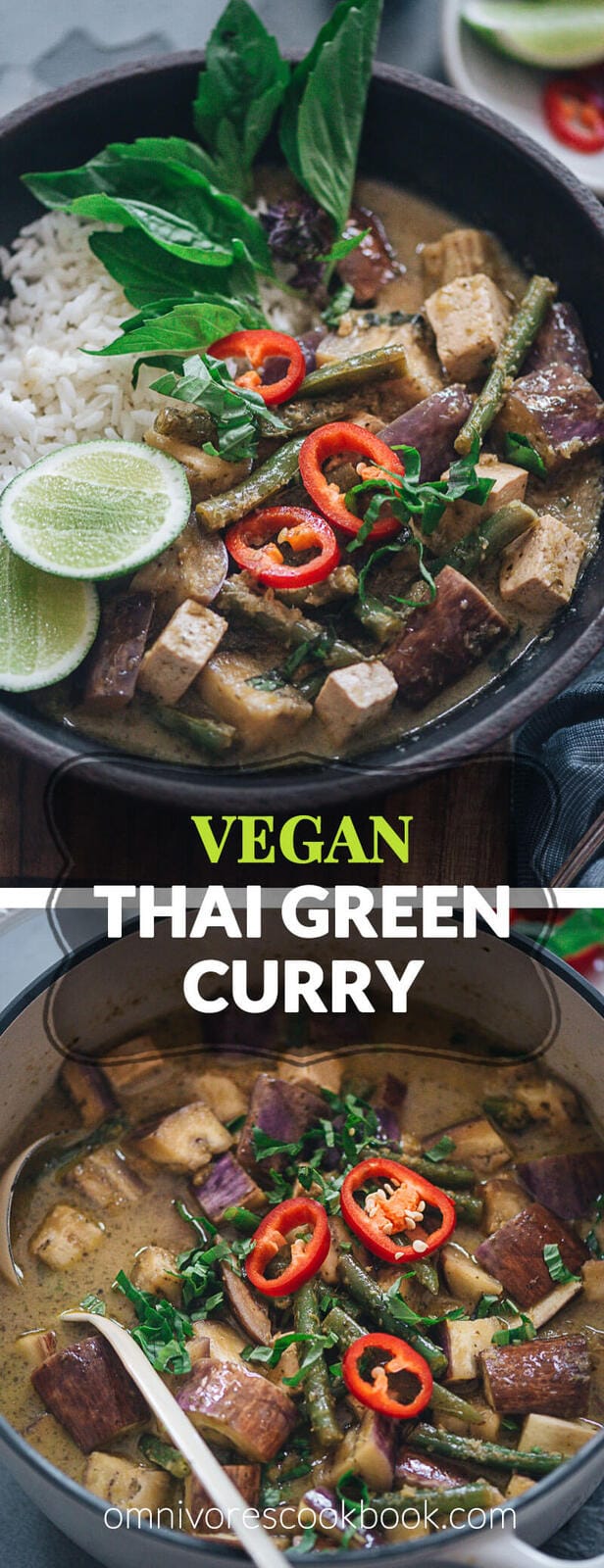

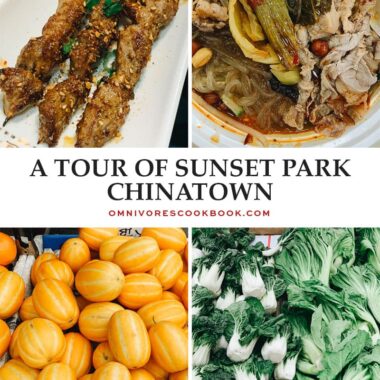
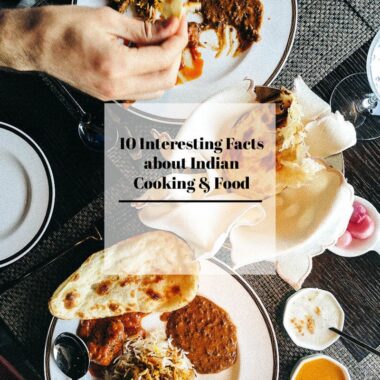
Ellen L
Loved this recipe. Some labor up front prepping everything, but came together easily. I liked the fact that the only fat added to the dish was the can of coconut milk. I plan to incorporate the techniques of this dish into other future dishes. The eggplant was nice and tender.
Grace Yeo
I’m loving your site because you keep giving me fresh ideas. I had gotten into a rut cooking for my Chinese husband. A couple additional steps I took that made this so lovely: Make curry paste in CuisineArt, transfer to molcajete, finish in
blender. Super smooth that way. Add curry to coconut milk to flavour, then strain out sediment. Coconut milk back in my wok, then added other ingredients. Delightful. Thank you!